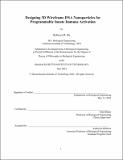Designing 3D Wireframe DNA Nanoparticles for Programmable Innate Immune Activation
Author(s)
Du, Rebecca R.
DownloadThesis PDF (14.19Mb)
Advisor
Bathe, Mark
Terms of use
Metadata
Show full item recordAbstract
DNA nanotechnology harnesses the predictability and specificity of canonical base pairing interactions to enable the synthesis of complex DNA nanodevices capable of interacting with their environment in a controllable manner. Wireframe DNA origami are a class of highly customizable DNA nanoparticles that can be folded into near-arbitrary 2D or 3D geometries upon which ligands can be attached and organized with nanoscale precision. Due to their versatility, DNA origami have been designed for a wide range of applications in a variety of fields ranging from chemistry to computer science, and there is substantial interest in harnessing DNA nanostructures for therapeutic applications. However, an understanding of how the immune system responds to wireframe DNA nanostructures is currently lacking. Furthermore, it is unclear how controllable design parameters such as scaffold sequence, nanoparticle geometry, or ligand organization influence immune activation.
In my thesis, I begin by describing a method for scalable bioproduction of circular single-stranded DNA that provides a high degree of sequence control and opens up opportunities for scaffold engineering. I demonstrate the design and production of two different scaffolds in both shaker flask and bioreactor setups, then validate the application of this method towards DNA nanotechnology by characterizing the successful folding of wireframe DNA origami from each scaffold. Using nanoparticles folded from one of these engineered scaffolds, I next investigate the molecular mechanisms by which wireframe DNA nanoparticles interact with innate immune receptors. I start by characterizing immunological recognition of unmodified wireframe nanoparticles and find that they induce Type I IFN expression primarily through cGAS-STING, while TLR9 is very minimally activated. I then enhance the ability of these nanoparticles to activate TLR9 by attaching discrete copy numbers of immunostimulatory CpG motifs at precise spatial positions and show that activation levels can be controllably tuned by changing the nanoscale organization of CpGs on the nanoparticle. Finally, I delve further into how design parameters such as nanoparticle geometry, inter-CpG distance, CpG copy number, and spatial presentation can be used to modulate innate immune activation. Overall, this work identifies specific nanoparticle properties that impact immunological recognition and sheds light on design principles that enable the production of immunomodulatory DNA origami.
Date issued
2022-05Department
Massachusetts Institute of Technology. Department of Biological EngineeringPublisher
Massachusetts Institute of Technology